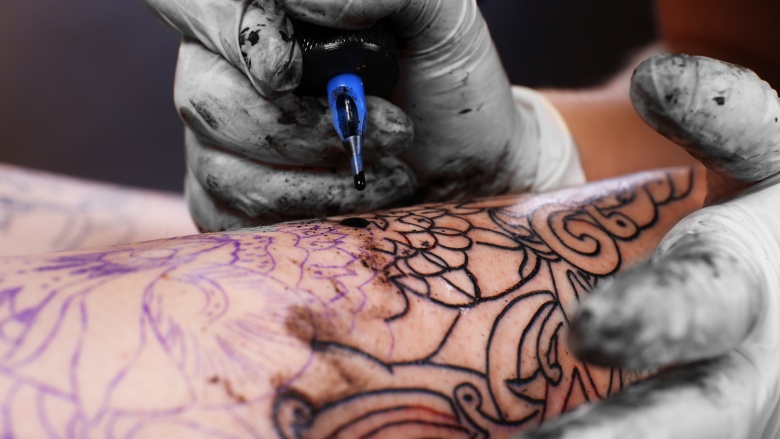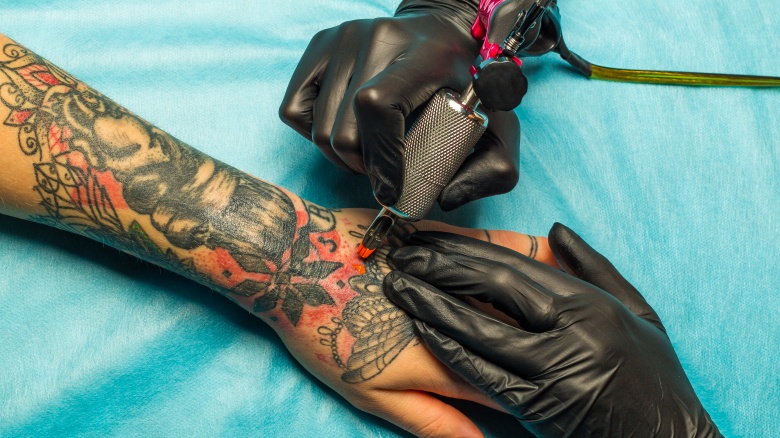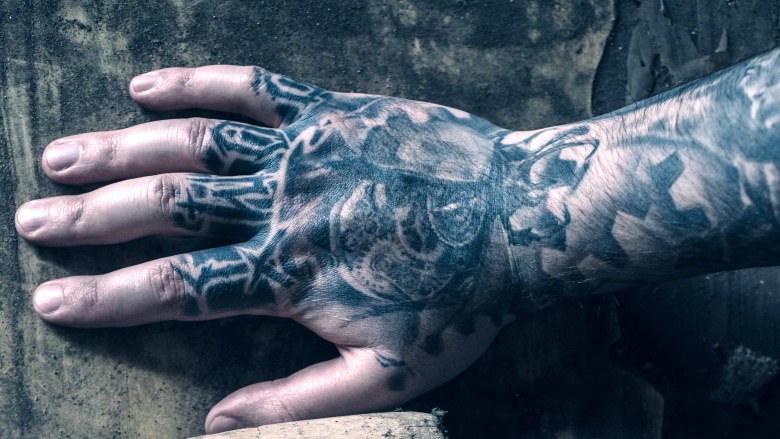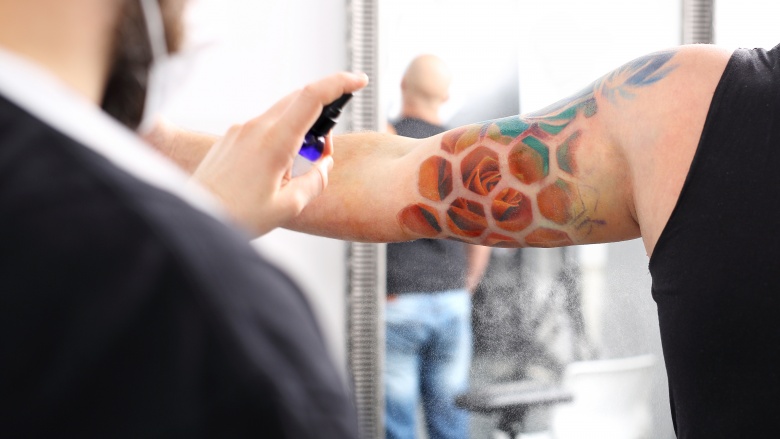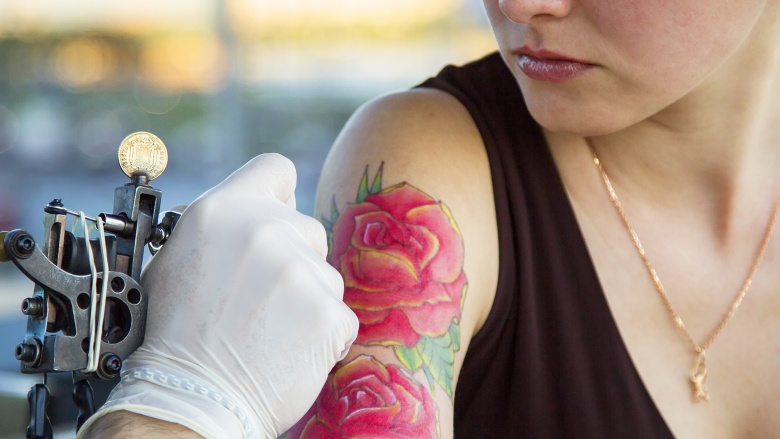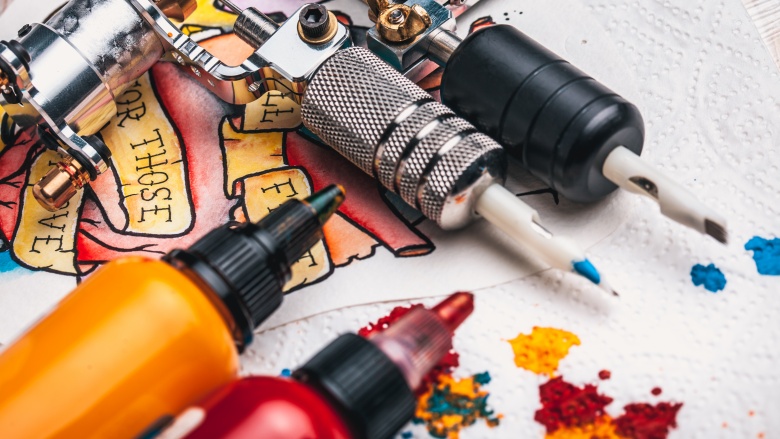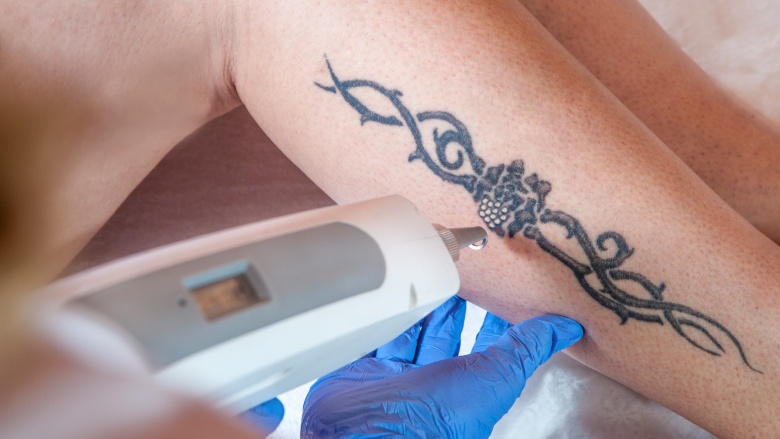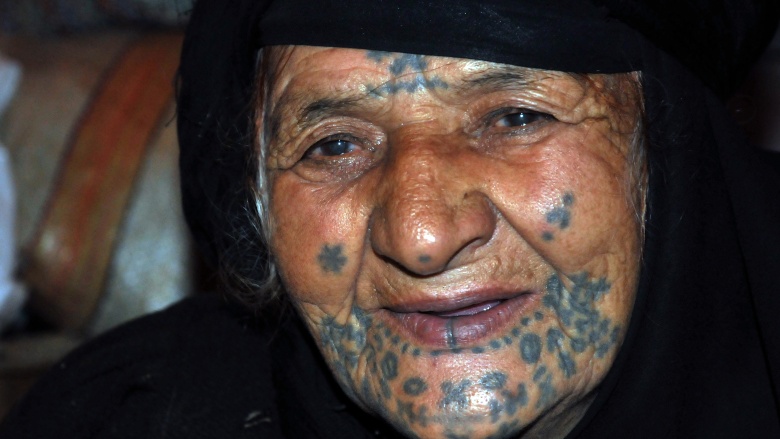What Really Happens To Your Body When You Get A Tattoo
Tattooing has been around in various forms for thousands of years, and some of those tattoos have been preserved in a way that are still eerily beautiful today. We might not think of it while we're sitting in the chair, but we're participating in an ancient tradition that goes back generations and generations, where people chose to get tattooed for reasons we can only imagine. We've had plenty of time to improve on ancient methods, so that's just left us to ask about what's going on in our own bodies as we subject them to this brief and beautiful torture.
Tattoos are more than skin deep
If you're an amateur, you might have a tattoo session that lasts half an hour. If you're hardcore, you could spend days in the chair just to complete a single piece. As you're sitting there, you know you're getting stabbed with tiny needles, but there's a lot more going on.
If the ink was just applied to your skin, it would wear off pretty quickly. All those surface skin cells are replaced in between 2 and 3 weeks. Since tattoos are a commitment that lasts longer than most Hollywood marriages, there's got to be more going on. There is. All those tiny needles are punching through the top layers of skin (the epidermis) and into the next layer, called the dermis. The needles create punctures at speeds up to 3,000 times per minute, and along the way they're depositing ink in both the epidermis and the dermis. That particular part of your body is rich with capillaries, and those tiny blood vessels draw the ink deeper into the skin. Tell that to the teachers that always warned you about the dangers of drawing on yourself with a pen.
Your immune system goes on the attack
With each puncture, your body becomes more and more convinced you're enduring something that is the immune system's equivalent of the apocalypse. That immune system dispatches cells called macrophages to put an end to the breach and lock down the particles of ink your body labels as intruders. The macrophages get sent to provide a clean-up service not because of the punctures themselves, but because of the inflammation that happens because of the repeated trauma. These little cells are essentially the body's own anti-inflammatory agents, and they're dispatched to get rid of whatever irritants are causing the reaction.
The macrophages essentially devour the ink, but after they've gorged themselves, the swollen bodies get stuck in what's described as a gel-like matrix that exists beneath your skin. Skin cells called fibroblasts also help soak up the intruding dye, and once they've eaten their share of pigment, they stay right there, too. They're unable to ferry the ink away to be processed and disposed of, and that's why we're permanently colorful. It's also why tattoos are never as bright as they are during those first few days, as the ink settles in deeper and deeper and gets swallowed whole.
Why do some places hurt more?
There's nothing more annoying than going in for a session and finding out the person in the next cubicle can't take a little pain. Seriously, does anything good ever come without some pain? Low pain threshold aside, there are some parts of the body that will always hurt more than others. Getting your back or calves done? Easy. Your elbows or feet? Have fun.
The really painful places, like the elbow, hurt so much because there's not much between your skin and the bone. That means the needle is scraping across your bone doing that 3,000-times-a-minute thing, which is enough to make most people break into a sweat. The backs of the knees hurt a lot, largely because the skin there is soft and flexible without a muscle layer beneath the skin. For the same reasons, the armpit and surrounding area is another bad one. The ribs and sternum are bad because of the closeness of the bone to skin, and hands are a whole different matter. Factor in the lack of a muscle layer, all the tendons and ligaments in your fingers and just how many nerve endings there are in your hands, and you're in for a long afternoon.
Why are sunburns such a bad thing?
No one wants a sunburn (except for those weird people that like to peel them), but getting a sunburn on a tattoo is particularly bad. That's mostly because during the process of healing the sunburn, your skin will shed layers of itself in a disturbingly snakelike way, as we've all experienced. The worse the sunburn, the more layers have to go. That's particularly damaging if you have a fairly new tattoo and the ink hasn't settled all the way under the skin yet. Sunburned tattoos will fade a lot, and no one wants to sit through and pay for a session only to have it fade. Because black absorbs the light faster, black-and-gray tattoos (along with the black areas of color pieces) can burn faster than other parts.
What about other kinds of burns? You can control how long you're out in the sun and whether or not you lather up with sunscreen first, but what if you spill some boiling water on your fresh ink? Besides hurting like you wouldn't believe, you can burn a tattoo completely off if the burn is deep enough. (We're definitely not recommending it as a removal method, no matter how badly you misspelled your first love's name.) In case you do suffer a major burn, it's sometimes possible to fix the ink, but you'd probably have bigger problems if you managed to do that much damage.
How does the body heal?
What's worse than the pain of getting a tattoo? The relentless itching as it heals, and the knowledge that there's no way you can attempt to relieve that itching. You have your ink, but for the few days you're also going to have what's essentially a giant, open sore. As your immune system kicks into high gear to try to repair the damage, you're going to end up with something of a leaky mess, and that's putting it politely. The oozing is your body trying to get rid of all the little foreign invaders, and chances are it might succeed in getting rid of at least a bit of the ink. That's expected, though. The clear stuff is blood plasma. It's trying to create the most impressive scab it possibly can, and mopping all that off will help keep the whole area clean.
In case no one warned you, getting a tattoo is a little gross. For the first few days, the irritation and injury will cause the whole area to be sore and feel a little feverish, but once that passes it'll start to peel like a sunburn. That week or so is probably worse than the pain of getting the tattoo. Get ready for a relentless, infuriating itch. Itching or peeling off skin before it's completely healed can ruin the whole piece, prevent ink from settling into the places it should, and generally make you all sorts of sad.
By about the second week (depending on the person, the location, and how heavy-handed the artist was), it should look pretty normal. Healing isn't finished, though, and it can take up to six months for everything under the skin to finish mending itself. Fortunately, the itching will be gone long before then.
Potential dangers of having an MRI
There aren't many people who will even mention this one, whether it's on the tattoo side or the medical side. If you have a tattoo and your doctor suggests you need to have an MRI done, for all that's holy, tell Doc about your tattoos. There's a tiny chance that having an MRI could burn you.
During an MRI, the body's cells are reacting to the presence of radio waves and magnets. The activity of the protons in your cells creates the grayscale images of the MRI, and that can also cause a problem with certain types of tattoo ink. There's a huge variety in the types of inks artists use, so a whole bunch of different materials might have been injected under your skin. (You probably won't know what's in the ink, but that's fine.) But some types of ink, particularly reds, can contain iron or iron oxides. If you know even the basics about science, you know that those things react pretty strongly to magnets. In some cases (again, rare but terrifying cases), your body starts to act sort of like a magnetic conductor. The iron in the pigments starts to heat up from well under your skin, and there have been some cases where patients have suffered second- and third-degree burns from the process. Others report only irritation and swelling, and if you're having an MRI done, you don't want to have anything extra to worry about.
Permanent makeup tattoos are among the biggest culprits here, and they're also the most dangerous. At least one woman suffered first-degree burns from the permanent eyeliner she had done, and with no muscle or fat to even help protect these areas of the body ... yikes. Even the FDA stresses that most of the magnetic weirdness happening in your body when your ink reacts with an MRI is a minor inconvenience at best, but seriously. Just tell your doctor.
What causes blow-out?
Tattoo blow-outs happen pretty rarely, and no one is 100 percent sure what's going on when they do happen. It generally occurs only a day or two after the tattoo is finished, when a hazy sort of cloudy discoloration spreads out from the tattoo. Most of the reported cases are blue, and it can happen anywhere on the body. If it happens once, it won't necessarily happen again, and even if you've gotten tattoos before without getting the discoloration, you could still get it with future tattoos.
Basically, what's going on is that the ink is spreading way beyond the limits of what should be the edge of the tattoo. While no one's really sure exactly why it's happening, it's thought the problem starts when the ink goes too deep beneath the skin. Instead of being injected mainly into the dermis, it ends up in subcutaneous fat, and can be more easily spread from there. Tools might have something to do with it, but since it's not that widely reported, there haven't been that many studies done. It can be covered with another tattoo, and laser removal has also been successful in getting rid of it. Maybe try a different ink shop next time.
What's the deal with laser removal?
So you didn't listen to anyone who tried to discourage you from getting the name of your significant other tattooed on you to celebrate your one-month anniversary, and now you've got a bit of tattoo regret. Rather than just crossing it off and writing the next one's name underneath (not cool), you might be thinking about laser removal.
The lasers that do the removing are called Q-switch lasers, and they're sort of a sci-fi version of the needles that were originally used on your skin. They're incredibly small, very precise, and very fast. The little, super-hot bursts are essentially heating up a small section of those ink bubbles we talked about earlier. In order to make them small enough to be disposed of by the body, they have to be broken apart. Lasers do this by super-heating part of the ink bubble, and the difference in temperature literally rips the ink apart.
Super-heating? That's right. Each laser burst heats the ink to several thousand degrees, and it's so precise that it heats just the ink instead of frying your skin to a state we like to call extra-crispy. The temperature isn't sustained and shatters in a shockwave under the skin that breaks up the ink you've come to hate. And you'd better hate it, as laser removal usually takes a whole bunch of sessions, and it's a heck of a lot more painful than getting that tattoo in the first place was. If that's not enough to encourage informed choices, nothing is.
What about tattoo removal cream?
The short answer is a simple one: most tattoo creams don't work. That's because most are only applied to the surface of your skin, and you know now that the most visible parts of the tattoo are underneath that upper layer. That makes it sort of wishful thinking ... but that might be changing with a deal between a Ph.D. student at Dalhousie University and Cipher Pharmaceuticals.
Alec Falkenham looked at something that previous tattoo removal cream inventors hadn't bothered with: the actual mechanics of how tattoos become permanent. His cream was designed to get under the skin to destroy those same macrophages that are holding your ink in place. Once they're broken down, the body sends a whole new army to escort the old macrophages and the ink from the premises. Hard to predict if it'll fix the bad tattoo problem or if more people are going to be getting them.
The science behind medicinal and therapeutic tattooing
Tattooing has been around for thousands of years, in spite of the fact that a certain percentage of the population still believes anyone who gets a visible tattoo is an unemployable heathen. Otzi the Iceman lived about 5,300 years ago, and his tattoos seem to indicate that they weren't just for decoration, they were medicinal.
So what's going on there? Otzi had a series of tattoos on some of his joints, and when researchers looked underneath his skin, they found that those joints showed signs of arthritis. The tattoos were incredibly dark, suggesting those spots had been done over and over again. He also had tattoos on his back, too, and those tattoos corresponded to acupuncture locations used to relieve ailments in the liver, spleen, stomach, and gall bladder. His body was so well-preserved that the remains of the worms in his system were still there. It seems likely that those particular tattoos were done to relieve that rather gross abdominal discomfort.
Lars Krutak is a researcher for the Natural History Museum of the Smithsonian, and he's done extensive work on documenting the cultural practices and beliefs that surround tattooing in different parts of the world. According to him, these ancient bodies like Otzi's and similar remains in Siberia all suggest that tattooing was done in a medicinal capacity because it acted exactly like acupuncture in Eastern medicine. In Canadian groups, facial tattoos were found to be connected with the treatment of paralysis from stroke, and 15th-century mummies from Greenland show the same distinctive markings that 19th-century explorers reported observing in the people they were just meeting. Then, those explorers recorded that tattooing was done in cases of severe illness, and Native Americans have used it for everything from relieving the pressure of a toothache to consumption. It remains a modern practice in many parts of the world, not only relieving pressure and pain in the same way acupuncture does, but also thought to give a person control over the flow of energy through the body and spirit.
Makes your little zodiac sign seem pretty insignificant, doesn't it?

